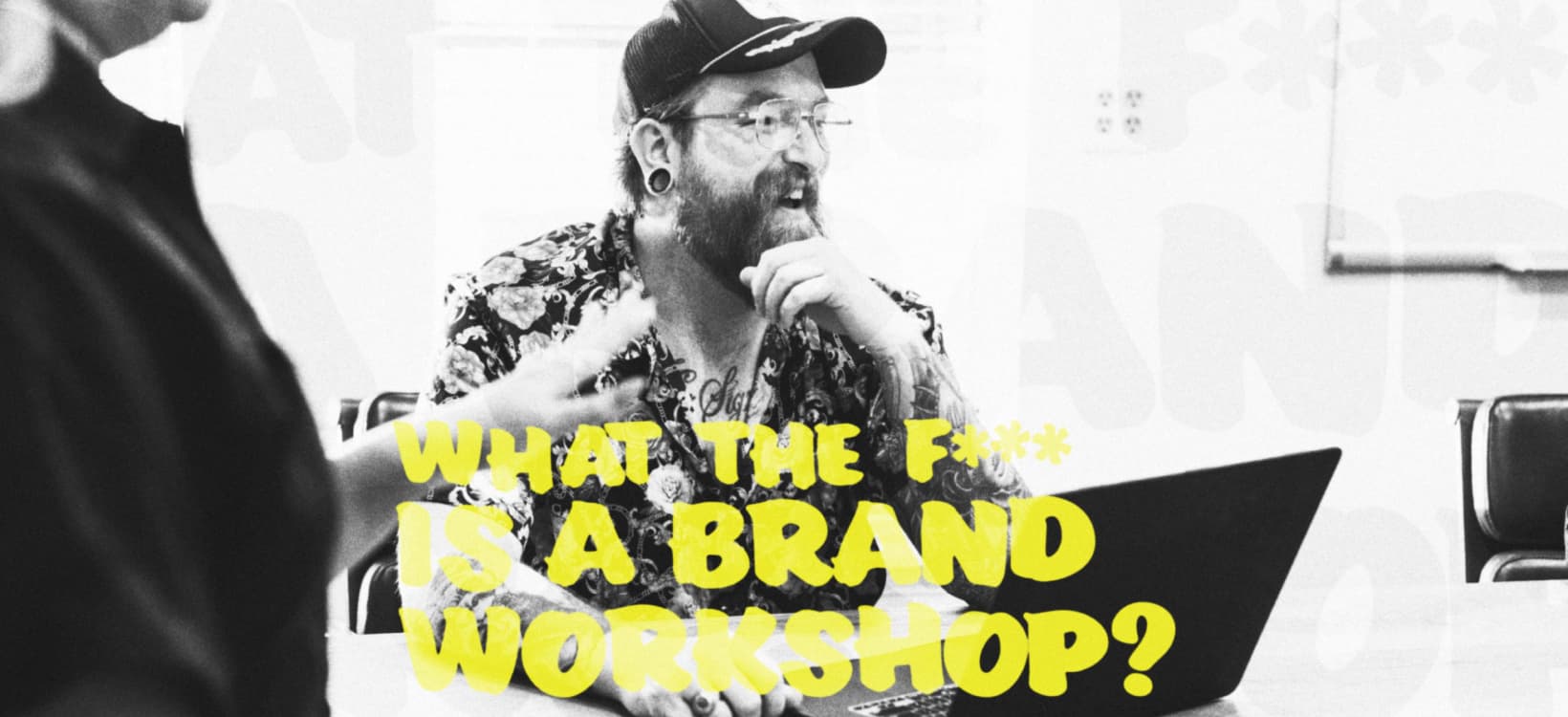April 14, 2022
What the F*** is a Brand Workshop
4 min readThe term brand workshop gets thrown around more than Cirque du Soleil performers. With vague marketing language and buzzword-filled descriptions, it can be tough to know what you’re actually getting for your dollars. Not to mention these exercises can look different depending on the company facilitating the workshop and the goals of the brand workshop.
Below I’ll break down:
- What brand workshops entail
- Who they benefit
- Why you might need one
- Our brand workshop process
- The ideal time for a brand workshop
So what is a brand workshop?
In almost every instance, a brand workshop is an olympic platform deep dive into your company, goals, products, services, communication strategies, visual preferences, and most importantly, your customers. It’s turning on the lights, sweeping the cobwebs, and creating “keep” and “trash” piles in your brand’s long ignored storage room.
Workshops typically last a day or two, and involve every stakeholder for the brand. The brand workshop itself is all about information gathering through a series of exercises. This allows brand strategists to see the entire scope of the brand and target audience, and use our magical powers to plot a company wide path forward. Like your bar buddy whose superpower is seeing paths through the crowd to get served before anyone else, these workshops help companies see paths to getting noticed and gaining fans before their competitors.
Who needs a brand workshop?
While brand workshops are great for companies of any size or age, those that see the most benefit tend to be startups looking to make an immediate impact, and larger companies looking to realign with a shifting market.
If you hear this around your office, it’s probably time to schedule a brand workshop:
- “They asked for our brand guide, do we have that?”
- “Sometimes it is hard for me to explain what we do here”
- “Do we know who we’re targeting with this ad?”
- “Do we do social marketing?”
- “I’m not sure who has access to our website”
- “When you say google analytics, do you mean our email?”
- “Which version of the logo is that?”
- “Does anyone know where we get these printed?”
Why does a brand workshop help?
“A team is a fist, not five fingers.” – Coach K
Companies tend to expand like foam insulation, filling every new adjacent service they can in order to keep growing. This can lead to a company that offers a ton of services, but feels impossible to market to new customers in a concise way. Conversely, a startup without a clear vision may expand into new areas that hurt their business by fracturing their messaging and stressing their team.
Having clear messaging, brand identity, and core values can make your employees feel unified, your messaging impactful, save you money on bad advertising or ventures, and can potentially save your entire company.
In The Culture Code, Daniel Coyle tells the story of Johnson and Johnson during the Tylenol murders of 1982, and how clear company values cost the company $100 million but eventually saved the company. Here is an excerpt, but I can’t recommend the full book enough.
“What should they tell the public? What should they do with Tylenol products on the shelves around the nation? The FBI and FDA strongly recommended they limit the recall to Chicago. The team thought about it, then ignored the advice. They ordered an immediate, national recall of every Tylenol product – at a cost of $100 million. When asked “Why?”, what do you think they said? “We believe our first responsibility is to doctors, nurses and patients; to mothers and fathers and all others who use our products and services.” The words of their mission statement led to their actions.
Over the next few weeks, they transformed themselves into a public safety organization. They publicly expressed regret and grief, and shared the steps they were taking to ensure safety. Six weeks later, they introduced new tamper-proof packaging. And then, something unexpected happened. Their market share, after dropping to zero after the attacks, began to slowly climb back and surpass previous levels.
Thousands of decisions needed to be made by J&J people to lead to the positive outcome. Each of those decisions resulted from a strong culture that created employees whose hearts and minds were focused on serving the patients first.
Hopefully your company never faces a nightmare of this magnitude, but having a brand that your customers and employees believe in can help guide decisions and regain trust.
Cool. So how does this all work?
Just like those recipe blogs, I made you scroll a while for the good stuff.
I’ve observed and facilitated a lot of brand workshops through the years, and while each company is a little different, here are the bones of our brand workshop. Each of these bullet points encapsulates a number of questions and exercises.
- General Company Info
- History
- Motivations
- Marketing History
- Marketing Budget
- Income and Profit
- Current Branding
- Current Language
- Company Voice
- Tag-lines / Naming Structures
- Mission / Values
- Audience
- Current Audience
- Target Audience
- Audience Behaviors
- Profitability of New / Old Audiences
- Customer Journey
- Core Values
- Current Impact
- Long Term Impact
- Why?
- Messaging / Voice
- Visual Identity
- Current Visuals
- Preferences
- Current Market Audit
- Voice Definition
- Voice Examples
- Clarifying Statement
- Reassurance Statement
The magic of these workshops is getting everyone in the same room to tackle these complex conversations. A lot of clients describe these sessions as business therapy, and we couldn’t agree more. Sometimes there are disagreements and painful memories, but everyone leaves feeling better (and with a piece of chocolate).
Here at Drift, we take all the information we’ve gathered in the workshop, plus some hefty market research, and put together a set of recommendations. These can range from the expected (like a rebrand) to out-of-the-box (like a more comfortable waiting area for parents during gymnastic classes). While that example sounds flippant, parents making purchasing decisions for their children’s classes will sign up for a gym with a couch and a free coffee over one with a metal bench, every single time.
These recommendations are typically broken up into phases based on your budget, and your bandwidth to make changes to your brand. If the recommendations aren’t feasible, then the workshop isn’t worth much, so understanding the budget and capabilities of staff are a crucial part of any brand workshop.
When should I start this process?
Ideally, you should start any new company with a brand workshop. If you missed that boat, there are some other clear indicators:
- Growth has slowed in your core demographic
- There has been a disruption in your industries products / services
- Turnover is high / applications are low
- Your swag looks lame at the trade show
- Trying to explain your business at a networking event requires an adderall
So what are you waiting for, a formal invitation? Send me an email at martin@driftingcreatives.com and let’s get it.






